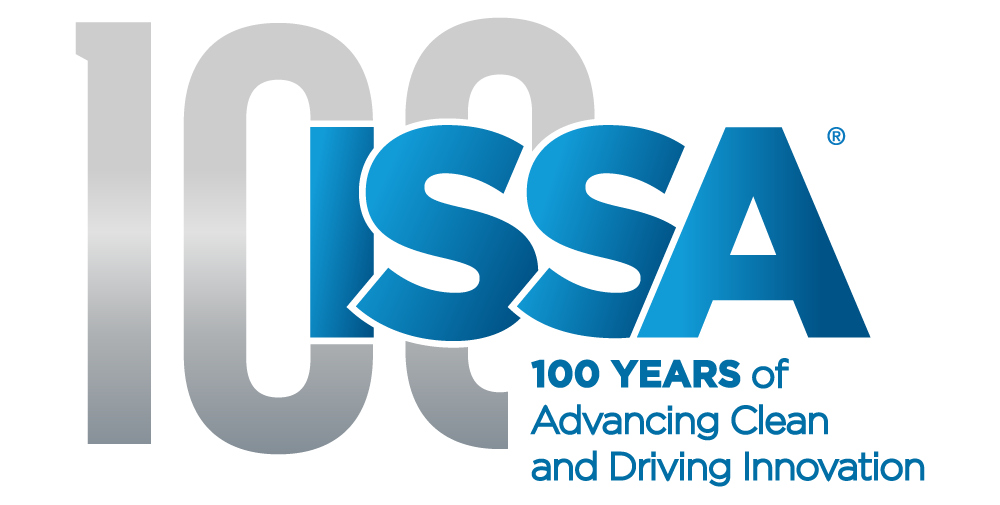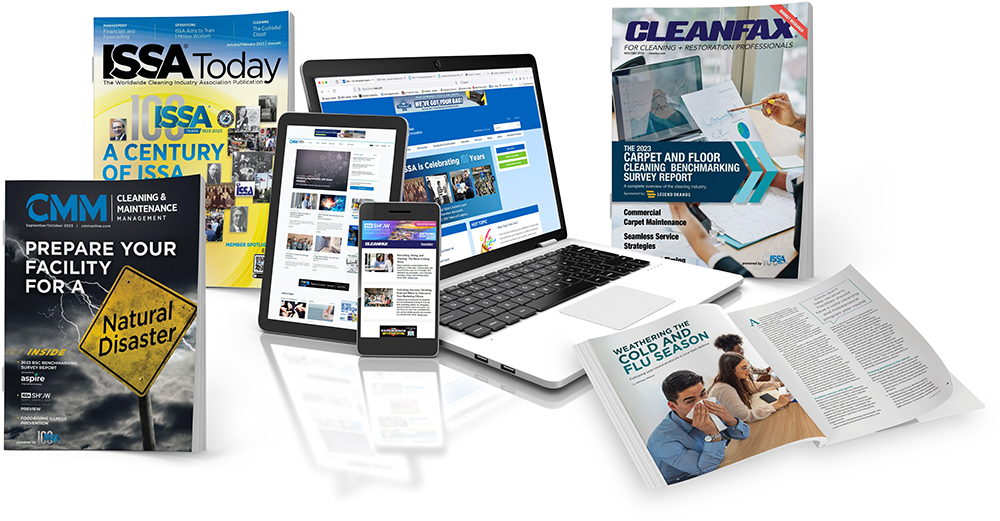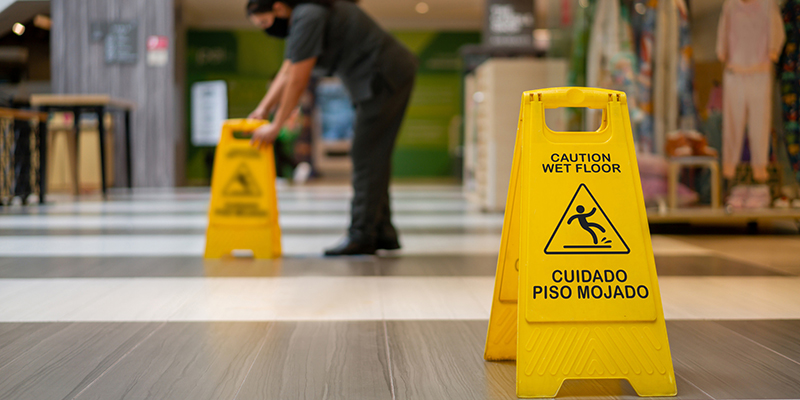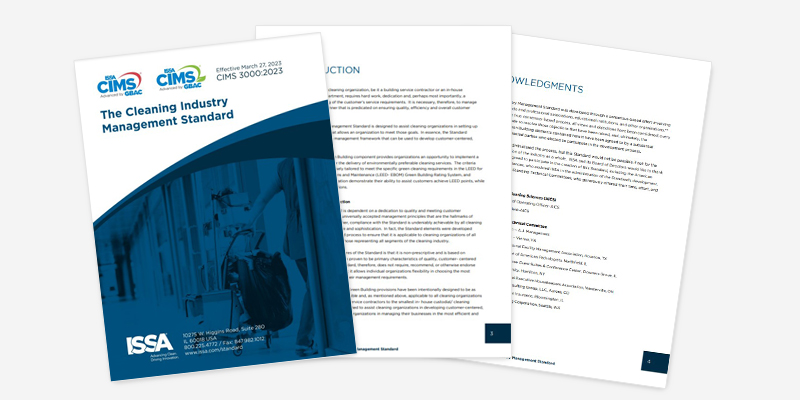The Law of Gravity

The law of gravity tells us what is airborne must fall—which turns flooring and all other horizontal surfaces into pathogen landing pads. Combating this contamination requires proper cleaning to remove soils and pathogens. Only after effective cleaning—and only in certain circumstances—do surfaces typically require disinfecting. When they do, choosing the right formula for the job is critical.
A word to the wise
Overuse or misuse of disinfectants creates health, environmental, and safety problems, including risks associated with human and animal overexposure, poor indoor air quality, microbial resistance, and the deterioration of assets. So, for surfaces that can be cleaned, to remove soils and pathogens effectively, there is no need to disinfect, and doing so can cause more harm than good.
Of course, there are circumstances in which disinfecting is necessary, in health care settings or during an outbreak, such as the recent COVID-19 pandemic, for example. In these instances, it is important to remember that just as all surfaces are not the same, neither are disinfectants. Therefore, making the best choice possible can protect the health of facility occupants, the environment, and extend the life of facility assets, while saving money, labor, and time.
There are many factors to consider when choosing the best disinfectant for the task. These include physical considerations, such as the composition of the surface(s) being disinfected, the location, and the targeted microbes. For example, if you are cleaning up blood from a hospital countertop, you would use a different disinfectant than if you are disinfecting an office desk. Similarly, if you are disinfecting metal fixtures, you would use a noncorrosive disinfectant, but probably not the same one you would use on a finished floor.
In addition to health and environmental risks, disinfectants vary in efficacy, concentration, cost, kill claims, dwell times, and rinsing requirements. Therefore, disinfectants should be selected carefully and specifically for the intended application, and the manufacturer’s label should be followed at all times. It is also critical to have staff who are educated regarding the importance of their roles and trained to follow proper disinfecting procedures.
Chemical considerations
Keeping the above in mind, below are some chemical facts that must be considered when selecting the best disinfectant for the job.
Water quality. The amount of calcium and magnesium in the water determines whether your water is hard or soft. These minerals can interact with a disinfectant, forming insoluble particles and reducing the kill rate of certain disinfectants. This is especially important when using concentrates through a dilution dispenser.
pH. A disinfectant’s acidity or alkalinity (pH) is another potential qualifier in your decision. The pH is determined using a scale of one to 14, where seven is neutral. Below seven is considered acidic; above seven is alkaline. Disinfectants with too low a pH may be unable to produce desired results. A pH that is too high can damage the finish on floors, fixtures, and other surfaces, while eroding equipment components and harming the environment.
Temperature and humidity. Very high temperatures can cause disinfectants to degrade, reducing their germicidal effectiveness. In addition, high humidity can change the composition of some disinfectants.
Organic vs. inorganic. Organic matter, such as blood, pus, or fecal material, can create a chemical reaction that reduces some germicides’ effectiveness. Organic material can also create a physical barrier, sheltering microorganisms from the disinfectant.
Dwell time. Disinfectant labels list the amount of time the formula must remain wet on the surface to do its job. Reducing this time can eliminate a disinfectant’s effectiveness. This poses a double danger in that a surface can carry potentially health-threatening pathogens, while giving people a false sense of security that the surface is properly disinfected.
Biofilm. In unscientific terms, biofilm is a thin, slimy film created by thick masses of cells that adhere to a surface. These biofilms are often caused by layers of disinfectant that were not removed by the required rinse or by not cleaning between disinfections. Disinfectants can fail because the biofilm shields the microorganisms from the antimicrobial formula or because the microbes have become resistant to the disinfectant. According to the Centers for Disease Control and Prevention (CDC), bacteria within biofilms are up to 1,000 times more resistant to antimicrobials than the same bacteria existing outside a biofilm. Currently, no formula is EPA-registered or FDA-approved to remove biofilm, so ensure your team cleans thoroughly before disinfection.
Dilution ratio. Ensuring that concentrated disinfectants are diluted following the manufacturer’s recommended parts per million (ppm) ratio is essential. Using a disinfectant at less than its recommended dilution ratio can create pathogen resistance requiring a higher-than-recommended ratio to be effective. The ppm ratio should be checked throughout the process of going from dispensers to bottles and buckets and during cleaning to determine protocols and frequencies for emptying, cleaning, rinsing, and refilling containers.
Potential pitfalls
Some disinfectants can:
- Discolor carpeting, luxury vinyl tile (LVT), wood floors, furniture, grout, doorknobs, and other hardware.
- Create pit marks/tiny holes in surfaces, including in metal fixtures.
- Buildup in floor grout, attracting additional dirt.
- Cause stickiness that attracts and retains soils on floors, desks, counters, and other surfaces in the building.
- Require a rinse after the stated dwell time, especially for food prep areas and surfaces that come in contact with skin, such as toilet seats and showers/tubs.
Validate, validate, validate: ATP and innovative options
As I wrote in A Clean Assessment in the last issue of ISSA Today, validating cleaning results has never been more critical.
Today, a visual check is not enough to ensure the safety of building occupants and instill faith in your team’s superior cleaning processes and protocols. As a leader, you need to know—and demand—evidence-based data tracking your cleaning results.
You need to know, not guess, that the surface contaminations have been dealt with effectively and efficiently without negatively impacting people, the environment, and your surfaces/assets. Back up your cleaning programs with science and data that supports what you are doing.
Much has been written about ATP meters and swab testing. While better than subjective visual checks and gel and black light technology, ATP meters are not without downfalls that must be managed. ATP meters are:
- Only able to detect potential bacteria, not viruses or fungi.
- Not the best teaching tool, since they don’t provide visual feedback pinpointing where the pathogens are and their distribution/spread.
- Expensive due to the cost of the meters, swabs, and required recalibrations.
- Impractical for tracking trends and driving improvements due to the number of swabs needed.
- Inaccurate when readings pick up chemical residue.
- Unreliable if swabs are obtained or taken from some surfaces, but not others that may harbor pathogens.
Remember, for most facilities, thorough cleaning is enough, and refraining from unnecessary disinfecting will help preserve the health of the cleaning staff and building occupants and visitors, the environment, and your facility’s assets.
But when disinfecting is required, choose the best formula for the job, and validate the results. You and your facility’s occupants will be glad you did.
Helpful Tools
Today, new technologies are also available for testing surface contamination. One is fluorescence imaging, which can be used independently, or in combination with ATP. While the products within this technology operate differently, they provide demonstrated benefits, including visual data pinpointing the exact location of pathogens, and illustrating the distribution/spread of the pathogens on the surface. These two benefits can then direct where ATP swabbing should occur. They can also be used to develop more effective training and result validation.
One product is a hand-held, non-contact imaging device. Picture a large flashlight with four different bulbs that identify and visualize the presence of bacteria, biofilm, mold, and organic and inorganic matter. Another product is positioned for smaller areas and works much like a camera in a scope to record results.
Another relies on fluorescence labeling and multi-spectrum imaging to allow users to visualize surface contamination. The images are captured using a customized, multi-spectrum camera and processed using proprietary software to determine if bacteria are present along with the relative amounts and distribution/spread. The equipment is leased, and the overall cost is comparable to an effective ATP meter validation program.




